

This is an activity designed to find a number that you might not expect to find so easily, the number of hairs on a human head!
Alas you say, "But every head is DIFFERENT."
To which we reply, "True, but mathematically, using random sampling and proportions we can come up with a pretty good estimate."
Follow the steps below and you may be surprised.

You are going to need the following stuff:
- At least one head of hair.
(If you do this for several people your answers can be averaged to get a more true estimate of the human population. Try to randomly sample. Pick female, male, black, white, Asian, old, young, balding etc.) - A 1/16 sq.cm. square template cut out of an index card to help count small amounts of hair.
- A calculator
- A measuring tape
- A paper clip or very small crochet hook

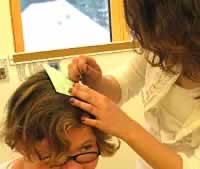
STEP 1:
Lay your sampling square template on the top of your subject's head. Gently open the paper clip, and use the tip of the metal to pull hairs through the square template. (NOTE: you can use a very small crochet hook to do this also.)
Carefully count these hairs and record the number of top hairs.
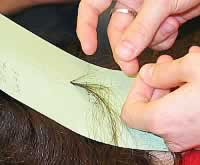
STEP 2:
It is quite possible that the hair is not as plentiful on the top of your subject's head as on the back or sides; so we must sample both the back and side as in step 2. Do this now, and record the number of back hairs and side hairs.
Now add the total hairs that you have found in these three squares and record.
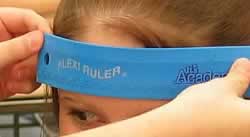
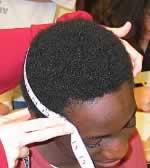
STEP 3:
At this point you know how many hairs are on 3/16ths of a square centimeter.
So it's now time to find out how many TOTAL square centimeters are on your subject's head.
For this we will use the tape measure or a ruler.
Section off the head into several
rectangular shapes as shown below, and measure the area of each in square
centimeters.



Your results here will not be EXACT, but they will give a fairly good
estimate

STEP 4:
Next we set up a simple proportion comparing the number of hairs to the number of square inches. It will look like this:


STEP 5:
Solving this proportion for 'h' gives a good approximation of the number of hairs on your subject's head.
TEACHER IDEAS:
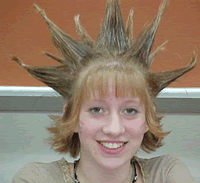
- Extend
this activity by combining all the data and then determining how
many hairs are on all of the kids in the entire school. (Ask
your office for the student population to help set up a new proportion.)
- Use
this same method to determine how many blades of grass are in
a plot of ground outside your school. You'll need a larger template,
we recommend 1 sq. in. Assign 2 to four students to measure the length
and width of the plot in feet and the rest of the class should be spread
out to count how many blades of grass fit inside their sample square
inch. Discuss random sampling here.
Then set up the proportion back in class. Make sure to change feet to inches and to get your total area in square inches.
This activity makes for a quick "field trip". It also gives the kids a feel for the magnitude of large numbers.
*We found 312,236,307 blades of grass in a field 180 feet by 270 feet.
- You can use the above method to find the number of holes in the ceiling of your classroom, assuming that your room has accoustical ceiling tiles
